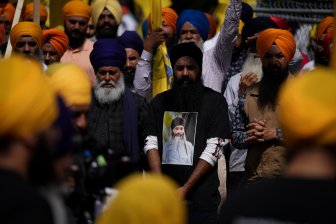An inmate at an Ontario jail told provincial police he saw correctional officers beating Soleiman Faqiri “as hard as they could” after getting him inside his cell, a coroner’s inquest into the mentally ill man’s death heard Tuesday.

The inquest watched a video recording of John Thibeault’s interview with Ontario Provincial Police on Aug. 14, 2019. Thibeault was being held at the Central East Correctional Centre in the cell across from Faqiri’s and told police he witnessed part of the events leading up to the man’s death on Dec. 15, 2016.
Jurors also heard testimony Tuesday from Ontario’s top forensic pathologist, who said he had found Faqiri’s death was caused by a “perfect storm” of factors, including an existing heart condition, the injuries and exhaustion from his struggle with the guards and exposure to pepper spray.
In the video shown at the inquest, Thibeault told a provincial police investigator the door to Faqiri’s cell was open and he had a clear view through a window in the door of his own cell.
He recalled that Faqiri was taken to the door of the cell by a group of correctional officers, and said one of them whispered something in Faqiri’s ear that made the man not want to go inside. Thibeault said one of the officers pepper sprayed Faqiri in the face, and they were then able to get him inside.
Once they crossed the threshold, the four officers who had been holding Faqiri began “beating the (expletive) out of him,” Thibeault said.
“They all started laying into him as hard as they could,” hitting him with their fists, he told police.
- S&P/TSX composite up Friday, U.S. stock markets rally after jobs report shows cooling
- Shocking videos show officer hit by vehicle during Toronto auto theft takedown
- Man facing charges after alleged afterhours Greater Toronto Area theatre shootings
- Ontario midwives can now administer routine vaccines, prescribe more drugs
Faqiri was knocked down a few times, and the officers were “all over him like pitbulls, like sharks,” he said.
At one point, Faqiri tried to run towards the back of the cell before he was dragged back, Thibeault said. When Faqiri got up a second time, he was pepper sprayed again, and the foam seemed to go into his mouth, he said.
“He wasn’t fighting back, he was just trying to get away from them,” Thibeault said.
Thibeault said he saw officers kicking Faqiri’s head, stomping on him and one kneeling on his neck. The beating stopped when Faqiri stopped moving, and officers then started yelling at him to stop resisting, Thibeault told police.
Thibeault said one of the officers then noticed he was watching and ran over to slam the shutter on his window. He then heard someone call a code blue – a call for assistance – and boots running down the hall. Thibeault said he heard a call for nurses shortly afterward, and more running down the hall.
“I didn’t know what was going on,” he said.
The inquest has heard Faqiri was arrested in early December 2016 on assault allegations related to an incident that took place when he was in a mental health crisis, and his condition deteriorated quickly while in the Lindsay, Ont., jail. At no time did he see a psychiatrist while in jail, nor was he taken to hospital, the inquest heard.
Faqiri died in his cell the afternoon of Dec. 15, 2016 after a violent struggle that began as he was being escorted from the shower to his cell.
He was subjected to “various incidents of use of force” in the moments leading up to his death, according to an agreed statement of facts. Faqiri was then left alone, face down with his hands cuffed behind his back and a spit hood – a face covering meant to prevent someone from spitting or biting – on his head, inside his cell for close to a minute until a manager became concerned that he wasn’t breathing, the statement said.
Also on Tuesday, the inquest heard from Dr. Michael Pollanen, Ontario’s chief forensic pathologist, who issued a report on Faqiri’s death in 2021.
The coroner’s office had previously found that the cause of death was “unascertainable” but Pollanen reviewed the case, factoring in information he was provided about the circumstances of Faqiri’s death. He told the inquest the combination of medical evidence and the factual context he was given allowed him to determine a cause of death.
He found Faqiri had an enlarged heart, which put him at risk of fatal arrhythmia, particularly when exposed to factors that could trigger a catecholaminic response.
Catecholamines are hormones the body releases in response to physical or emotional stress, and are responsible for the so-called “fight-or-flight” response.
While none of Faqiri’s injuries individually caused his death, together they would have contributed to such a response, and played a significant role in his death, as would his exhaustion, the pathologist found. The fact that Faqiri was restrained face down, which can affect breathing, and exposed to pepper spray, also likely contributed to his death, Pollanen said.
The pathologist said neck compression couldn’t be ruled out as a contributing factor, but the autopsy results didn’t support that as a probable cause. He noted the classic injuries indicating neck compression, including pinpoint hemorrhages in the face and eyes, weren’t present during the autopsy.
Pollanen also said he didn’t find the spit hood was a contributing factor, since there was no evidence it impeded Faqiri’s breathing or that Faqiri had breathed in any fluid.
Under cross-examination, Pollanen also agreed the injuries seen at autopsy did not support allegations that anyone stomped on Faqiri’s head.




Comments